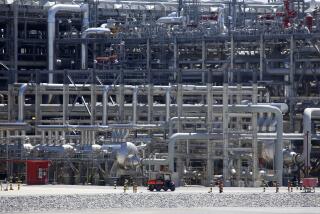Wider World, Higher Costs for Natural Gas
- Share via
A newsroom colleague used to offer up a clear-cut, two-word solution whenever natural gas prices would soar: “Bomb Canada.”
But, alas, things aren’t so simple -- especially not these days.
Long regarded as an energy source that was basically inexpensive, natural gas has entered a new age, a period comparable to the era of price rises that hit the oil industry starting in the 1970s.
With production declining in the United States and Canada, gas supplies are expected to be particularly tight in the next five years, with prices averaging about $5 per thousand cubic feet -- more than three times the level of the late 1990s.
Highly volatile, prices will spike frequently. In turn, that will force utilities, which burn natural gas to produce electricity, to add energy surcharges onto their bills.
U.S. industry already is feeling the pinch. Aluminum smelters have been shuttered. Fertilizer production has been reduced because of the effect of rising gas prices on the cost of ammonia. Some American companies are saying that they need to think about locating their factories in the Middle East to access cheaper natural gas. And producers of petrochemicals -- the raw material for clothing fibers and plastics -- are petitioning Congress to reduce the use of gas by electric utilities so there is more left for them.
Yet, for all the hand-wringing, the long-term supply outlook is not so bleak.
World reserves of gas are actually abundant, including deposits in Egypt, West Africa, the Middle East, parts of Asia and Australia -- even North America. The key is erecting pipelines and other delivery systems to bring these supplies to industrial markets.
Fortunately, that’s just what is starting to happen.
On the North Slope of Alaska, for example, natural gas produced along with oil has long been pumped back into the ground because no gas pipeline exists to bring the fuel to the Lower 48 states. But energy experts now anticipate that such a pipeline will, at long last, be built by 2010.
Meanwhile, the world is seeing a growing trade in liquefied natural gas, a method of transporting the fuel across oceans in specialized tankers; terminals freeze the gas at one end and then warm it up and regasify it at the other.
Such LNG “trains,” as they are known in the parlance of the industry, cost about $5 billion each to build.
Many see the investment as a wise one. For instance, ConocoPhillips Inc. is forming a partnership with Qatar’s state petroleum company to construct a large LNG train to bring gas to the U.S. Sempra Energy, the San Diego utility holding company, is obtaining permits to build an LNG terminal in Ensenada, Mexico, and to expand a similar terminal in Cameron, La.
The worldwide spurt in LNG projects also is providing growth to a 114-year-old firm, Chicago Bridge & Iron Co. -- CB&I; today -- which constructs storage vessels. CB&I; recently received a big order for an LNG facility at Elba Island, Ga., near Savannah.
In all, about 20 LNG terminals are operating or being planned in North America.
But Europe has even more such projects underway, according to Stuart Wagner of Petrie Parkman & Co., a Denver firm specializing in energy issues.
Ultimately, if the U.S. isn’t careful, Europe’s greater ability to import LNG could give it a competitive edge in chemicals and other basic industries that rely heavily on natural gas.
Indeed, when Federal Reserve Chairman Alan Greenspan recently testified to Congress about natural gas prices, his central point was that the United States must accept the building of more LNG regasification terminals on our home turf -- or we will see our economy suffer.
There will, of course, be a cost for employing all of this new technology: Gas prices will, on average, be considerably higher than they’ve been historically.
“Natural gas has reached an inflection point,” says Michael Zenker, the Oakland-based head of natural gas studies for Cambridge Energy Research Associates.
In many ways, the concern about natural gas seems to have come out of nowhere. Throughout the 1990s, use of this environmentally friendly fuel increased significantly; 90% of all the electric power plants recently built or on the drawing board are gas-fired.
But natural gas reserves peaked in the U.S. and Canada as new discoveries failed to replenish rising annual production. In 2001, a wave of drilling for new gas yielded markedly disappointing results.
In addition, political decisions banning exploration for gas in the waters off the East and West coasts have kept potential supplies off the market. Daniel Yergin, head of Cambridge Energy, estimates that 100 trillion cubic feet of gas reserves -- more than five years of total usage in the U.S. -- are waiting to be tapped offshore.
The way ahead for natural gas is fairly clear if we look at what has happened since the oil shock of 30 years ago.
In that case, companies and consumers adapted. Cars today get better mileage than they did in the early ‘70s, and industry achieves greater output on half the energy input required three decades ago.
In the years ahead, we will similarly see conservation of natural gas and adroit new uses for the fuel and feedstock. We’ll also see the emergence of a worldwide gas market, replete with tanker ships and technological advances.
Yes, prices will be higher -- but the feeling of crisis will ebb as new supplies come on line. And Canada, it seems, will be able to rest easy once again.
*
James Flanigan can be reached at jim.flanigan @latimes.com.
More to Read
Sign up for Essential California
The most important California stories and recommendations in your inbox every morning.
You may occasionally receive promotional content from the Los Angeles Times.










